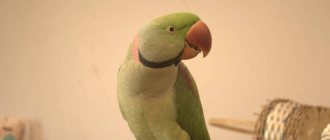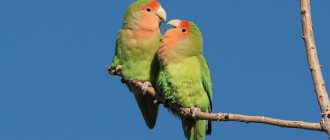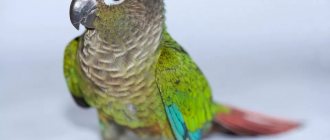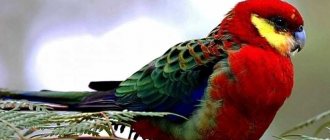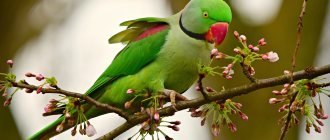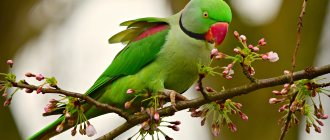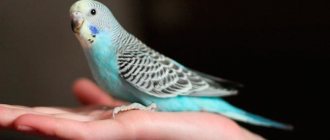Necklace parrots are medium-sized birds with a narrow stepped tail, a strong beak and pointed wings. Thanks to their developed intelligence and relaxed disposition, they quickly win new fans and become more and more popular every year. And if the decision to join the ranks of owners of necklace parrots is finally made, you need to find out in advance about the characteristics of these birds.
Appearance and size of the bird
Necklace parrots are small in size and grow up to 30-50 cm with a weight of no more than 150 g. They are divided into several varieties, the differences between which are in the size and color of the plumage.
According to the general description, a necklace parrot should look like this:
- The beak is large, bright red. Often used when walking as an auxiliary support.
- The body is slender and lean.
- The wings are long, with pointed tips.
- The limbs are grayish-pink, short, poorly developed, with 4 fingers.
- The tail is long and multi-layered.
- The plumage is emerald green. There is an orange border near the eyes. The inner part of the wings is painted gray, and the outer part is strewn with yellow-green spots. On the neck of the male there is a necklace in the shape of a darkened stripe.
Interesting! Although the necklace parrot is naturally camouflaged green, breeders have bred birds with white, blue, yellow and even colored feathers. Of particular interest for home breeding is the blue necklace parrot with its unique coloring.
Types of necklace parrots
The necklace or ringed parrot is divided into the following varieties:
- Rose-breasted. Most of the bird's body is green. The head is covered with blue feathers. The chest and upper half of the abdomen are pink.
- Grey-headed. It has yellow fluff on its cheeks and a dark gray head. The remaining parts of the body are covered with green plumage.
- Redhead. It is colored in grassy-olive shades and has a dark red head with a lilac sheen.
- Malabar. A gray bird with blue-green wings and pale yellow down around the eyes, on the belly and at the bottom of the tail.
- Mauritian. It is completely green in color and inhabits Mauritius, Madagascar and other islands washed by the Indian Ocean.
- Alexandrov. Large green parrots with a pinkish “necklace” with a black outline.
- Himalayan. A bright green parrot with dark gray plumage on the neck and head.
- Finsch's parrot. It has a dark gray head and green color with scarlet splashes.
- Kramer's parrot. It is divided into 2 subspecies - the African ringed parrot and the Indian parrot. It is painted green with a gray-blue tint and has a “necklace” of black and rich lilac-pink stripes.
- Threadtail. Lime green parrot with red stripes on the sides of the head.
- Emerald necklace parrot. A bird with green plumage, a blue-gray back and head.
- Pink-headed. Green parrot with a gray-pink head.
- Chinese ringed. A large green parrot with lilac-blue plumage on the chest, abdomen and head.
On a note. Depending on the type, the cost of a parrot varies from 8,000 to 20,000 rubles.
Character and behavior
Necklace parrots are cheerful, good-natured and sociable birds that easily get along with people. They have a curious disposition and are capable of all sorts of pranks. Necklace parrots can chew cables, cage bars, books and furniture, and also drag any objects they like into their home.
Playful birds love to look at their own reflection and can spend hours looking in the mirror.
Necklace parrots are very susceptible to any disturbances and noise at night. Therefore, it is not advisable to take them into families with small children. Also, these birds are intolerant of the company of same-sex relatives, especially if they are smaller and weaker than them.
They immediately strive to gain a leadership position and do not allow their opponents to approach the toys, drinking bowl and feeding trough. Therefore, keeping two males in one cage at once is highly not recommended.
Natural enemies
In nature, its enemies are birds of prey, such as owls, crows, jays, and snakes are dangerous for clutches. Some temperate climate animals that can climb trees, such as squirrels, ferrets and weasels, also pose a risk to them.
Most often, it is not an adult bird that is attacked, which can always fly away or fight off, but rather nests with eggs or chicks. Also the enemy is the person who catches these birds for sale. But in general, no serious threats to populations have been noted anywhere.
In places where there is serious damage to crops, people take control of the increase in numbers. They are driven away by loud sounds, shots, and eggs are also removed from the nests. Birds that conflict with them include tits, pigeons, starlings, and nuthatches. Basically, all clashes with them occur over a place for a nest.
Keeping at home
Ringed parrots are unpretentious birds; they easily adapt to different conditions. Although they take root well in any climate, it is advisable to create the most comfortable conditions for them.
For good health, birds need a temperature of no lower than 18 degrees Celsius and a humidity of no higher than 70%. To make the air in the room where exotic birds live cleaner, it is recommended to install an ionizer there. Otherwise, the care and maintenance of the necklace parrot is practically no different from the care of other tropical birds.
Arrangement of the cage
To keep a ringed parrot, you need a durable cage with a height of at least 70 cm and a length of 50 cm. For a pair of birds, you will need a more spacious home with an area of at least 2-3 m2. The necklace parrot's cage should be made of corrosion-resistant metal.
Inside, drinkers, feeders, perches, a mirror, bells, ladders and other interesting accessories must be placed.
Care and feeding
Caring for a parrot is not difficult even for novice poultry keepers. It comes down to maintaining cleanliness in the cage and proper feeding of the bird. The ringed parrot's home is regularly cleaned, which includes washing drinking bowls, food bowls and toys.
In addition to keeping the cage clean, you also need to take care of the bird itself. To prevent the necklace parrot from getting sick, it is recommended to bathe it periodically. You need to gradually accustom your bird to bath procedures. First, the parrot is sprayed with a spray bottle, and when it gets used to it and stops being afraid, a tank of water is placed in the cage.
The necklace parrot feeds on industrial and home-made grain mixtures. One bird eats an average of 2-3 tbsp per day. l. stern. The basis of its diet is millet, wheat, oats, canary seed and sunflower. The ringed parrot is also given corn grits and boiled peas.
During the period of feeding the chicks, the female can be given:
- milk porridge with added fish oil;
- boiled eggs;
- oatmeal;
- raw grated carrots;
- crumbled wheat bread;
- skim cheese.
The ringed parrot eats vegetables, berries, fruits, branches of fruit trees, seasonal greens, chopped acorns and chestnuts with appetite. Occasionally he can be treated to boiled fish, peeled nuts and insects.
On a note. To compensate for the deficiency of nutrients, the necklace parrot is given mineral supplements made from clay, ground eggshells, activated carbon, chalk, clean sand, tableted glycerophosphate, ash and bone meal.
Education and training
Necklace parrots are quite shy and refuse to approach the bowl of food at any incomprehensible noise. In order for them to quickly adapt to life in captivity, they should not be disturbed unnecessarily.
At the initial stage, the birds scatter a small amount of grain in the cage and wait for it to start pecking. Later, food is offered from the palm.
Necklace parrots are smart and quick-witted birds that can copy human speech. On average, they remember about 60 words, and some individuals memorize 200-250 words. Males no older than 12-16 weeks are best trained. During classes, they are isolated from other birds and trained 2-3 times a day.
The parrot, which is sitting on your finger, is raised to the level of your lips and the words are repeated in a loud, clear voice.
Lifespan and reproduction in captivity
Domesticated necklace parrots are stronger than their wild counterparts. Their average lifespan is 10-30 years. But there are cases when they live for half a century.
Ringed parrots breed without problems at home. But to obtain viable offspring, it is recommended to mate birds that have reached 36 months of age. To encourage parrots to reproduce, the cage with them is moved closer to the home with other birds. A house measuring 30x30x50 cm must be placed inside, the bottom of which is strewn with a mixture of wet peat and sawdust.
The mating period for birds lasts 8-10 days. The male beautifully looks after the female, offers the chosen one a treat and talks to her in a melodious voice. After this, the female lays up to 5 eggs and incubates them for 22-23 days. After 6-7 weeks, the chicks become independent and are ready to leave the nest.
Necklace parrots are small, beautiful birds with an inquisitive and non-aggressive disposition. They are endowed with developed intelligence and, with proper care, will become interesting companions for those who do not like silence.
Nutrition
Their menu mostly consists of seeds and juicy fruits, but it is possible that they can eat animal food to replenish protein. At least they can often be seen near the anthill. They are looking for something there and raking it with their paws. As already mentioned, they are busy searching for food in the morning and evening.
Fruits, berries, and nuts are the traditional food of these birds. Date, guava and fig are their favorite menu. Sometimes among the fruit trees they encounter monkeys, but they can hardly be called competitors. Parrots remove fruits hanging on the thin ends of branches, but the monkey cannot reach them.
These birds love to feast on the nectar of flowers. They tear and throw away the petals to get to the sweet core. When plucking food, they cling tightly to a branch with their hooked fingers. In times of drought and lack of food, birds show prudent economy in food.
First, they drag the fruit closer to the beak with their paw, eat up the most delicious pulp, and then carefully take out the nourishing seeds. If there is a lot of food, they behave differently. They casually peck at the fruit, taking out everything most appetizing from it, in their opinion, and throwing the fruit itself to the ground.
In captivity, they feed on grain mixtures, fruits, and vegetables. They are even given some boiled meat to supplement their protein. Sometimes they behave like real robbers. In search of food, they open bags of grain or rice on open trains. The sharp beak easily tears the shell of any package, so other goods, for example, nuts, fruits and berries in boxes, also suffer.



